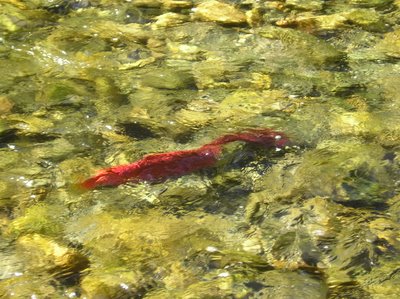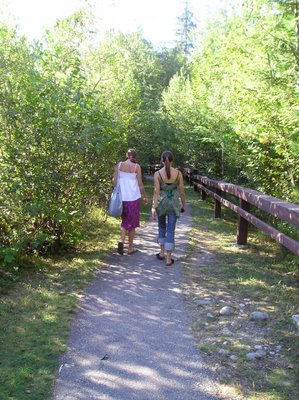Saturday, September 30, 2006
The landlocked salmon of Kootenay Lake

 Many years ago, the lake I live on was teeming with sockeye salmon, which migrated down and up the Columbia River system (hundreds of kilometres). When the river was dammed (many times over), their access to the Pacific was cut off.
Many years ago, the lake I live on was teeming with sockeye salmon, which migrated down and up the Columbia River system (hundreds of kilometres). When the river was dammed (many times over), their access to the Pacific was cut off.They adapted by living in the deep cold waters of Kootenay Lake and by spawning up the many streams and rivers in it. They became smaller, yet continue the same life cycle.
When living in the main lake, they are bright silver - when they spawn, they stop eating and begin to absorb their scales, turning a bright red (body) and green (head). They are called Kokanee - which means 'red fish' in the local native (Ktunaxa) language.
As you probably know, they fight their way upstream, find a place to nest (in pairs)and after depositing, fertilizing and protecting their eggs... they die. Their flesh feeds animals, birds and the small organisms in the stream that their young will feed from. It's a cycle...
The photos are of my daughter and our Spanish exchange student, walking along a spawning channel... and of a pair of Kokanee fish in the stream. (click to see larger)
I grew up on Vancouver Island and I live in Vancouver, but I have never been to the Kootenays. I hear it's very beautiful there.
lake!
Best..
German: "Auch ein Ruecken kann entzuecken" :)
In his Book “A new Kind of Science” Wolfram discovered from his experiments, mimicking adaptive changes in nature, using simple repetitive mathematical instructive, over billions or computations, the patterns just kept on evolving, random evolving patterns.
He was able to reach the conclusion parts of our Darwinian theories are flawed.
That is inherent in biology is the ability to quickly adapt to create complex new life forms from non complex beginnings, effortlessly in very brief periods of time.
Colonization in biology of new environments will result in rapid specialisation to different selective regimes. Although a process of ecological specialisation occurred over millennia or centuries in evolution, not much is known about how quickly reproductive isolation actually evolves when new environments are first colonized.
Recent experiments with salmon, and other fish species show colonisation occurs rapidly.
Re productive isolation between two adjacent salmon populations of a common ancestry such as you have described with Salmon in Kootenay Lake,would have probably occurred in less than a dozen generations of salmon.
Good fishing or eating !!I know you would always throw them back !!
Good fishing
<< Home







Post a Comment